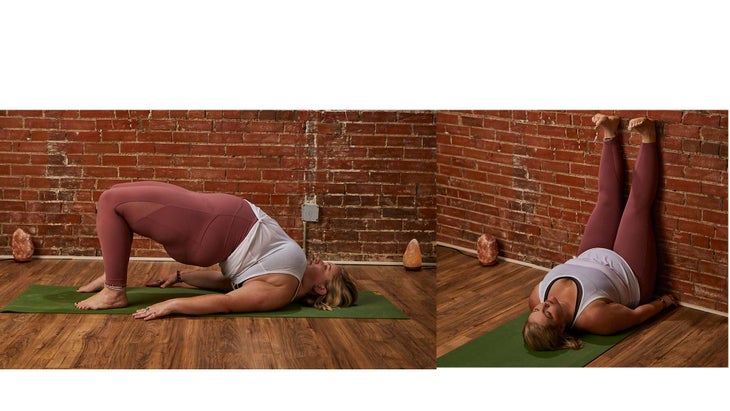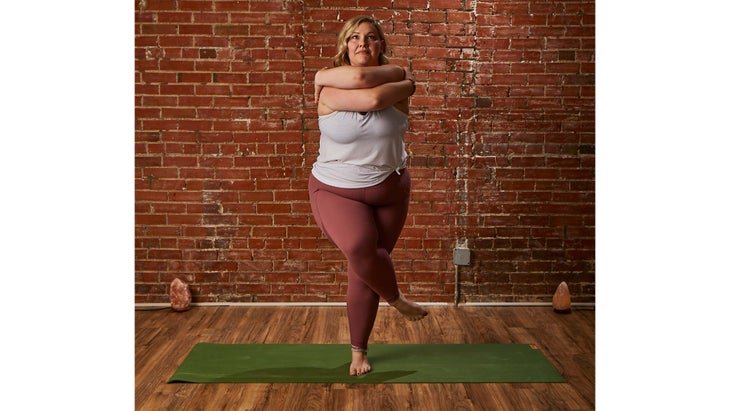“], “filter”: { “nextExceptions”: “img, blockquote, div”, “nextContainsExceptions”: “img, blockquote, a.btn, a.o-button”} }”>
As far as we know, the oldest systems of yoga were created by men. From that we can extrapolate that poses were designed for straight lines, not curves. What this means is certain poses will be challenging or even impossible for those of us with rather generous bosoms, no matter how flexible or strong we are.
So what’s a busty yoga student like me to do? We need to think beyond providing variations for the postures as we practice and teach. It’s not enough to merely adjust a posture to approximate the traditional shape. Remember, the postures in yoga create an effect in the subtle body as well as the physical body. We need to explore options that create the same effect, not just the same shape, especially for poses that bring our chest toward our thighs or our arms together in front of our chest.
Take Child’s Pose, which is designed to stretch the back and induce calm. Those of us who are large breasted and aren’t able to get our torso close to our knees or the mat will inevitably find it to be an ineffective back stretch. Propping yourself might help us replicate the traditional shape but won’t deliver the same stretch. Some of us would benefit from instead practicing Upavistha Konasana (Wide-Angle Seated Forward Bend) to accomplish what Child’s Pose does for the back or Savasana (Corpse Pose) to replicate what it does for the subtle body.
Following are some ways that can you adjust your practice to suit your unique stanabhara (Sanskrit for “breast weight”).
RELATED: Sports Bras Don’t Suck As Much As They Used To
5 Fixes for Yoga Poses That Are Uncomfortable When You Have Large Breasts
Garudasana (Eagle Pose)
The challenge for large-breasted women: This balancing posture opens the shoulders and back while strengthening the core and legs. The primary challenge is getting your arms into position in front of your chest.
The fix: Bring your arms into a self hug with your elbows on top of each other and your hands on opposite shoulders. (Think of it as the upper body equivalent of Fire Log.) Lift your elbows and keep them above chest level. Your legs and core can be in any Eagle variation.

Parivrtta Utkatasana (Revolved Chair Pose)
The challenge for large-breasted women: The traditional goal of Revolved Chair Pose is the twist. In so doing, you can either bring your arms into prayer position in front of your chest or touch your bottom hand to the floor while reaching your top arm upward. Each presents challenges when your breasts are voluminous. The arm stretch can be especially difficult in terms of bringing your upper chest past both of your thighs when your bottom arm is in front of your breasts. As a result, your twist becomes limited.
The fix: The traditional pose mandates your hips remain facing forward. But allow your hips to twist slightly and bring your bottom hand to your front knee rather than trying to reach the mat. This way, you can use your knee as leverage to increase the twist rather than open your chest.

Chaturanga Dandasana (Four-Limbed Staff Pose)
The challenge for large-breasted women: The weight of your breasts can draw your body out of safe alignment in the traditional version of Chaturanga. Even if your torso is aligned, your breasts will be closer to the floor than the rest of your body. To me, the physical benefits of Chaturanga (strengthening the arms and core) are less important than the subtle body benefits (connection to the breath during a challenging vinyasa practice).
The fix: I opt for the traditional Chaturanga a few times during my practice, but I also give myself permission to trade it for Plank Pose on my knees. Then I either lower myself fully to the floor in Bhujangasana (Cobra) or I take Urdhva Mukha Svasanana (Upward-Facing Dog).
RELATED: Why You May Want to Start Cross-Training for Chaturanga

Salamba Sarvangasana (Supported Shoulderstand)
The challenge for large-breasted women: Actually, Shoulderstand is a pose those of us who are generously endowed can often do although it can feel like we’re smothering ourselves. There are two main goals when practicing this pose: the inversion that lengthens the spine and the chin lock.
The fix: You can lengthen the back and receive the benefits of an inversion by instead coming into Viparita Karani (Legs Up the Wall. You can accomplish the chin lock by doing Setu Bandha Sarvangasana (Bridge Pose) and, if you’d like to stretch your spine, Uttansana (Standing Forward Bend).

Marichyasana (Seated Twist)
The challenge for large-breasted women: In my experience, the complication with seated spinal twists such as Marichyasana I and III is twofold: First, if you’re twisting to the left, it is difficult to get your right arm across the front of your body, even if you have the full twist in your hips and core. Second, it can be difficult to get your bent leg close to your torso. (Actually, any posture that’s extensively folded can be mighty difficult, with the possible exception of Standing Forward Bend, in which gravity assists you.
The fix: Forget the forward fold of Marichyasana I and focus on the twisting action of Marichyasana III. Keep your bottom leg straight and work the twist with your opposite hand resting on your bent knee rather than trying to hook that elbow in front of your leg.
RELATED: The Best Plus-Size Leggings
This article has been updated. Originally published June 26, 2018.

